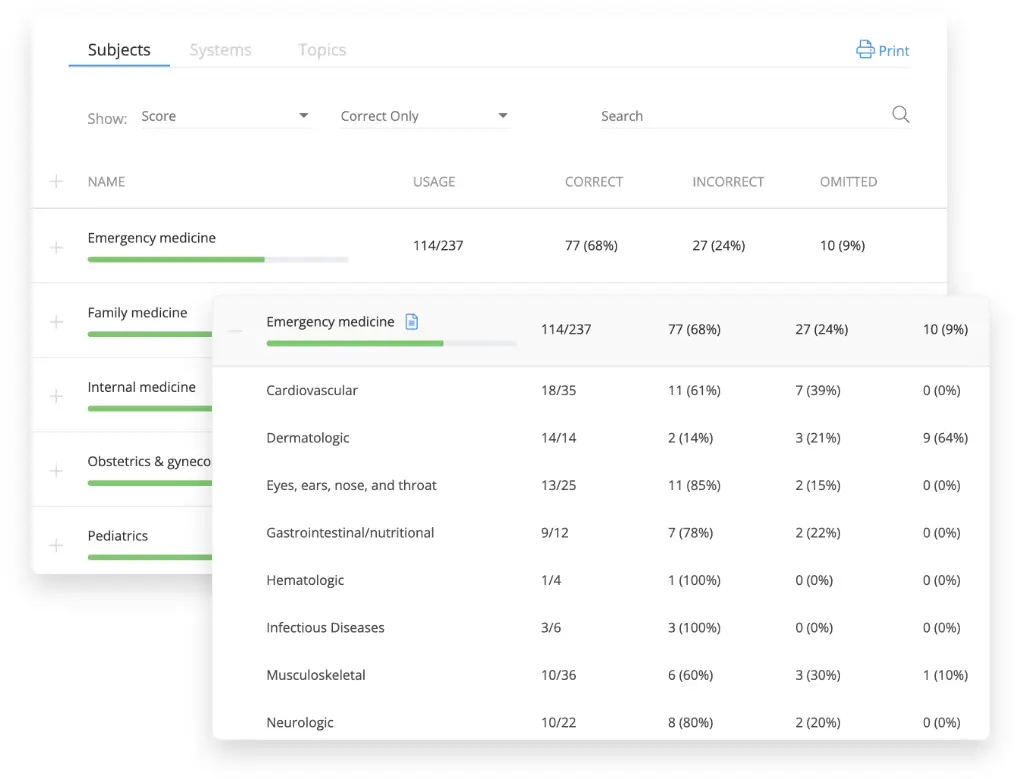The National Commission on Certification of Physician Assistants® (NCCPA®) requires PAs to pass the Physician Assistant National Recertifying Examination® (PANRE) every 10 years to maintain licensure. The exam itself is designed to ensure PAs remain up-to-date with modern medical practices. To help you develop a successful study strategy, we’ll walk you through how the PANRE is scored, what score you need to pass, historical pass rates, and related information.
How Is the PANRE Scored?
The PANRE is scored using a “scale-score” metric. By placing all scores on a unified scale, examinees of the same skill and knowledge level should achieve the same score regardless of which specific exam they take.
The minimum possible score is 200, while the maximum is 800. The PANRE passing score is 379 or higher.

How PANRE exams are standardized
The PANRE is taken in a 5-hour block consisting of four 60-minute testing sessions, 45 minutes of break time, and 15 minutes for a tutorial. Each testing session covers 60 questions, resulting in 240 total questions. While some questions may be reused across exams, each test form is unique. However, the NCCPA builds each PANRE to be equivalent in terms of the expected response time, task allocation, content blueprint, and overall difficulty level. This standardization is achieved through Automated Test Assembly (ATA), during which test forms are reviewed by two independent committees of PAs to make sure the questions cover relevant material and reflect current standards of care. Out-of-date questions are replaced with new questions that cover the same topic at approximately the same difficulty level. Test forms are then reviewed one final time to check that statistical features are uniform.
How many questions do you need to answer to pass the PANRE?
There is not a set number of questions PAs need to answer correctly to pass the PANRE. When exams are scored, correct answers receive 1 point and incorrect answers receive 0 points (this means it’s better to guess than leave an answer blank). These raw scores enter a “maximum likelihood estimation procedure” (based on the Rasch model), where the difficulty of the exam and number of correct responses are used to determine examinees’ proficiency measures. Proficiency measures are then converted into scaled scores based on the performance of a reference group whose scores scaled to an average of 500 (with a standard deviation of 100).
Why is the PANRE’s passing score 379?
The PANRE’s passing score of 379 was determined through a process called “standard setting.” This passing standard was set using the Angoff method, where experts settle on an appropriate pass mark. More specifically, a panel of PA content experts worked to ensure a passing score covered the core medical knowledge, abilities, and skills recertifying PAs should possess for safe and effective practice. They considered, “Would someone who is ‘just qualified’ answer this question correctly?’” Question-level ratings were aggregated to reach a recommended “cut score.” This score was then sent to the NCCPA Board of Directors for final approval.
Historical PANRE Pass Rates
In recent years, the PANRE has had a relatively high pass rate. First-time test takers have been passing more than 90% of the time, while over 95% of PAs eventually pass the exam to become recertified. This shows that, with proper preparation, the exam is manageable despite a full workload.
| PANRE pass rates for the years 2014–2018 | |||||||||
|---|---|---|---|---|---|---|---|---|---|
| Year Due | Total Due to Recertify | PAs taking at least one PANRE before recertification |
PAs passing PANRE on their first attempt |
PAs taking multiple PANRE before recertification |
PAs passing PANRE (first and multiple attempts) |
||||
| 2018 | 9,454* | 9,243 | 98% | 8,996 | 97% | 170 | 2% | 9,166 | 99% |
| 2017 | 15,321 | 14,468 | 94% | 13,673 | 95% | 649 | 4% | 14,179 | 98% |
| 2016 | 14,784 | 14,048 | 95% | 12,847 | 92% | 967 | 7% | 13,568 | 97% |
| 2015 | 13,616 | 13,018 | 96% | 11,886 | 91% | 846 | 6% | 12,501 | 96% |
| 2014 | 12,520 | 12,038 | 96% | 10,949 | 91% | 763 | 6% | 11,493 | 96% |
*Total of eligible PAs not registered in the Pilot Alternative to PANRE.
**Percentage of PAs passing is based on the number of PAs who tested and not on the total population of PAs who were due to recertify.
How to Know If You Passed the PANRE
You can check your PANRE score online through your NCCPA account. When you receive your score, you will also be able to review your performance in each content area via PANRE subscores. Subscores should be reviewed with caution, considering not every subtopic is tested on any one given exam. Even so, this information will help you determine your relative strengths and weaknesses as you continue your career as a PA.
When are PANRE scores released?
Your PANRE results are available approximately two weeks after your exam date. Remember, you must pass the PANRE with a score of 379 or higher, log 100 Continuing Medical Education (CME) credits, and submit a certification maintenance fee to complete your recertification.
What is a good PANRE score?
A good PANRE score could be considered 500 or higher. As previously discussed, a score of 500 was the average of the NCCPA’s reference group, while the minimum passing score was set a little more than 1 standard deviation below it at 379. Scoring well on the PANRE reflects strongly on your knowledge of current medical practices as a PA. We encourage you to strive for a high score, content knowledge in the PA profession is directly related to patient care.
What happens if you fail the PANRE?
If you fail the PANRE, you can retake it after a 90-day waiting period. You are permitted to take the PANRE a maximum of four times in your certification maintenance cycle (two times in your 9th year and up to three times in your 10th year). While you wait, we strongly recommend taking advantage of the UWorld PA QBank. It comes with robust performance tracking by subject and system, allowing you to identify your areas of weakness and remediate accordingly. It also simulates the exam’s interface, includes thousands of practice problems written in the exam’s format, and features in-depth rationales developed by practicing PAs.
How to Get a 500+ PANRE Score
The UWorld PA QBank is your best resource for achieving a high PANRE score. Each question is written to reflect the latest NCCPA blueprint and offer real-world insight from practicing PAs. Answer explanations are very thorough and feature rationales with professionally produced illustrations that bring PANRE concepts to life. As you complete the QBank, you can drill down into which topics require more work through personalized performance analytics. As PAs ourselves, we designed the program to fit your busy schedule, with integrated study tools perfect for at-home or on-the-go review.
“This Qbank has been amazing! The questions are difficult, but they provide meaningful feedback for correct vs. incorrect answer choices. I am challenged to think critically, which is essential for passing the exam. I also like the notebook and flashcard options; these tools have been a life saver when trying to remember such a high volume of information. I highly recommend UWorld.” – Erica
Read More About the PANRE
Learn what to expect from the PANRE, including content area breakdowns, the exam’s format, and crucial exam-day requirements.
Our PA experts created a personalized PANRE study guide to assist you in preparing for the exam based on your busy schedule and exam date.
PANRE Exam Eligibility, Registration & Cost
Is your certification maintenance cycle approaching? Learn what you need to do to become eligible to take the PANRE, how to register, and how much the exam costs.
Discover in how much detail each disease and disorder is tested on the PANRE according to the NCCPA blueprint, discussed on a level-by-level basis.






